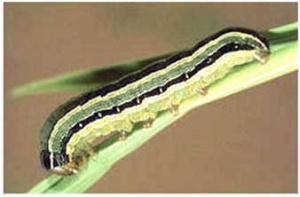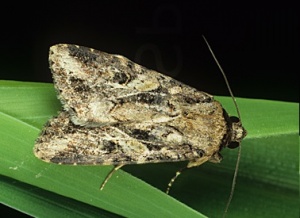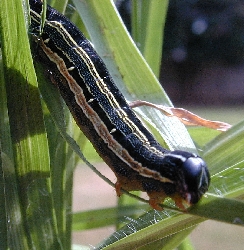Armyworm
African Armyworm - Spodoptera exempta


The African Armyworm (4 cm long) is also called Okalombo, Kommandowurm or nutgrass armyworm. At high density the caterpillars are black with yellow stripes. At low density, they are green or brown. They turn black when they are 10 days old. It is the larval stage of a moth. It does well on wet conditions and do not proliferate in dry conditions. The moths (av. 1.6 cm long, wingspan 3 cm) live about 10 days. One female maximally lays 1000 eggs in total. The eggs are laid in clusters on leaves, and hatch in 2–5 days. The egg mass is covered with black hairs from the female. Larval stage lasts 14 to 22 days; pupal phase takes 7 to 15 days; and adults lifespan is 5 to 16 days. Female moths lay eggs at night in batches of 10 to 300 eggs in one or more layers on the leaves or on other surfaces. In East Africa the total lifecycle lasts about 25 days at an average temperature of 26°C.[5]
Temperature
Temperature dominantly affects larval and pupal development time, larval and pupal survivorship and pupal weight. The higher the temperature (34°C, 28°C or 22°C), the faster they grow. Survivorship in larval and pupal stage is generally lower at 22°C. Larvae reared at high temperature exhibit lighter coloration.[6]
Diet
The Spodoptera exempta larvae feed on all types of wild grasses (Poaceae) and sedges (Cyperaceae), and on early stages of grains. They grow faster (and bigger) on well watered plants (80-90% moisture content) vs water stressed plants (60-70% MC). Survivorship is generally lower on water stressed plants in very young and older larvae.[7] Spodoptera exempta cannot easily adapt to physical defences such as silica. Silica in the leaves of grasses acts as a defence. Even with short-term exposure, but also progressively impacting with time, silica reduces the conversion efficiency of food into bodymass, and the amount of nitrogen absorbed from their food, leading to reduced growth rates. Exposure to silica-rich diets also caused an extremely rapid increased mandible wear.[8]
Not one specie
Within the Spodoptera genus, Spodotptera exempta is a group of species with high levels of genetic diversity. One study revealed 17 different haplotypes within a single population of armyworms [9], with a size variation of approximately 115 to 153 kb. [10]


